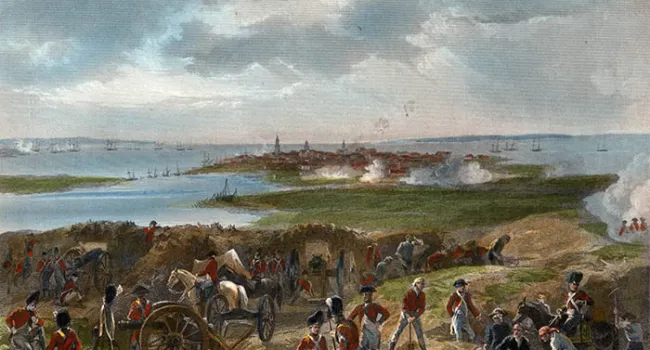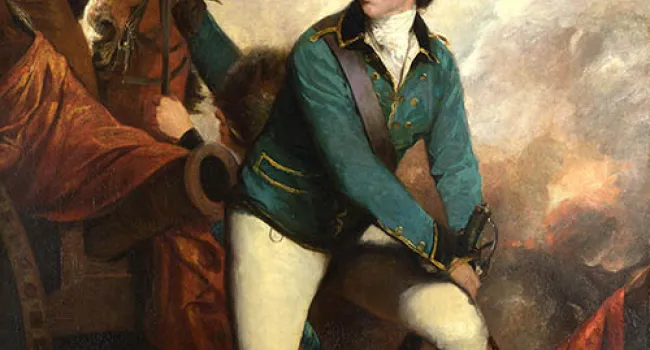
CREDIT: Colonel Abraham Buford, painted by Thomas Kelly Pauley, 2016
Colonel Abraham Buford was leading a regiment of Continental soldiers from Virginia to South Carolina to help defend Charleston. A group of soldiers coming from Charleston met them on the road and told them Charleston had already fallen into the British hands. Col. Buford decided to turn the men back towards North Carolina to keep the British from advancing into South Carolina.
On May 29, 1780, Lieutenant Colonel Banastre Tarleton and the British Legion caught up with Col. Buford’s army at a place called “The Waxhaws” in the Catawba River valley, located four miles south of the North Carolina border. Over in fifteen minutes and with 113 Americans dead on the field, this massacre became the first major battle of the Southern Campaign.
The Battle of Waxhaws also became a turning point in the Revolutionary War, but not for reasons the British might have hoped. Their intent was to make the back country colonists feel the “heel of the boot.”
Many patriots who had previously surrendered rejoined the fight to repay the harshness of “Tarleton’s quarter” with a vengeance of their own.
Standards
- 4.2.CE Examine the economic and political motivations for colonists to declare independence from Great Britain.
- 4.2.CX Contextualize South Carolina’s role in the development of the new nation.
- 8.2.CO Compare the motives and demographics of loyalists and patriots within South Carolina and the colonies.
- This indicator was developed to encourage inquiry into the economic, political, and social motivations of the patriots and the loyalists in the era of the American Revolution.
- 8.2.CE Explain the economic, political, and social factors surrounding the American Revolution.
- This indicator was developed to encourage inquiry into how the colonies began to unify to create a distinctive American identity over the course of events of the American Revolution.
- 8.2.CX Contextualize the roles of various groups of South Carolinians as the colonies moved toward becoming an independent nation.
- This indicator was developed to encourage inquiry into the motivations of colonists during the American Revolution and the progression of conflict and failed compromise that ultimately led to revolution.
Resources
You need to be logged in to listen to view this content. Create an account now; it's quick, easy, and free!
Log In to ViewEl Coronel Abraham Buford estaba dirigiendo un regimiento de soldados continentales de Virginia a Carolina del Sur para ayudar a defender Charleston. Un grupo de soldados que venían de Charleston los conocieron en la carretera y les dijeron que Charleston ya había caído en manos británicas. El coronel Buford decidió devolver los hombres hacia Carolina del Norte para evitar que los británicos avanzaran hacia Carolina del Sur.
El 29 de mayo de 1780, el Teniente Coronel Banastre Tarleton y la Legión Británica se reunieron con el ejército del coronel Buford en un lugar llamado "las Waxhaws" en el valle del río Catawba, ubicado a cuatro millas al sur de la frontera con Carolina del Norte. En quince minutos y con 113 estadounidenses muertos en el campo, esta masacre se convirtió en la primera gran batalla de la Campaña del Sur.
La batalla de Waxhaws también se convirtió en un punto de inflexión en la Guerra Revolucionaria, pero no por razones que los británicos podrían haber esperado. Su intención era hacer que los colonos de la zona o del campo sintieran el "talón de la bota".
Muchos patriotas que se habían rendido se reunieron a la lucha para pagar la dureza del “cuartel de Tarleton” con una venganza propia.







